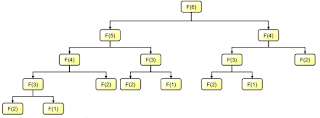1. What is Dynamic Programming?
- Dynamic programming solves problems by combining the solutions to subproblems. We typically apply dynamic programming to optimization problems. Such problems can have many possible solutions. Each solutions has a value, and we wish to find a solution with the optimal (maximum or minimum) value.
- A sequence of 4 steps:
- Recursively define the value of an optimal solution
- Compute the value of an optimal solution, typically in a bottom-up fashion
- Construct an optimal solution from computed information
- Dynamic programming and recursive are different:
- Dynamic programming starts at resolving smallest subproblems (base problems). From that, we resolve bigger problems until finding the result for biggest problem. (original problem). (bottom-up)
Example:
Fibonaci number
there are 2 methods to compute the fibonaci number bellow:
 |
| computing fibonaci number between recursive and dynamic programming |
the disadvantage of recursive:
 |
| F[6] computation |
2. Some optimization problems
2.1 Rod cutting
Problem description: how to cut a rod into rods of smaller length in way that maximizes their total value. I buy a long steel rod and cut it into shorter rods to sell.
Give a rod of length n inches and a table of prices pi for i= 1, 2, ..., n, determine the maximum revenue rn obtainable by cutting up the rod and selling the prices. If the price pn for a rod of length n is large enoughm, an optimal solution may require no cutting at all.
| A sample price table for rods. |
example: n = 4
the optimal strategy is part (c) - cutting the rod into 2 pieces of length 2 - which has total value 10.
 |
| the 8 possible ways of cutting up a rod of length 4 |
If an optimal solution cuts the rod into the k pieces, from some 1 <= k <= n, then an optimal decomposition
n = i1 + i2 + ... + ik;
of the rod ino pieces of lengths i1, i2, i3, .., ik provides maximum corresponding revenue
rn = pi1 + pi2 + .. + pik
 |
| the optimal result |
More generally, we can frame the values rn for n >= 1 in terms of optimal revenues from shorter rods:
the following simpler version of above equation:
 |
| bottom-up dynamic programming version of cut-rod problem |
#include <stdio.h>
int main()
{
int p[11] = {0, 1, 5, 8, 9, 10, 17, 17, 20, 24, 30};
int r[11];
int s[11];
int i, j;
int q;
r[0] = 0;
for(j = 1; j <= 10; j++)
{
q = -1;
for(i = 1; i <= j; i++)
{
if(q < p[i] + r[j-i])
{
q = p[i] + r[j-i];
s[j] = i;
}
}
r[j] = q;
}
for(i = 1; i <= 10; i++)
printf("r[%d] = %d, s[%d] = %d\n", i, r[i], i, s[i]);
return 0;
}
2.2 Matrix-chain multiplication
A1A2A3...An.
so how many are the minimum of scaler multiplications?
matrix-chain multiplication problem:
give a chain <A1, A2, .. An> of n matrices, where i = 1, 2,.., n, matrix Ai has dimension
Step 1:
Call m[i, j] is the optimal value of product Ai...Aj. (i <= j). we must split the product between Ak and Ak+1 for some integer k in range i <= k <=j. That is, for some value of k, we first compute the matrices Ai..k and Ak+1..j and then multiply them together to produce the final product Ai..j. The cost this way is the cost of computing the matrix Ai..j plus the cost pf computing Ak+1...j , plus the cost of multiplying them together.Step 2:
Step 3:
define s[i, j] to be a value of k at which we split the product AiAi+1...Aj in an optimal parenthesization. |
| The algorithm of matrix-chain |
and the below image shows the result of m and s array.
 |
| the m and s tables computed by Matrix-Chain-Order for n = 6 |
The result is ((A1(A2A3))((A4A5)(A6)
the C source code
#include <stdio.h>
#include <limits.h>
// Matrix Ai has dimension p[i-1] x p[i] for i = 1..n
int MatrixChainOrder(int p[], int n)
{
/* For simplicity of the program, one extra row and one
extra column are allocated in m[][]. 0th row and 0th
column of m[][] are not used */
int m[n][n];
int s[n][n];
int i, j, k, L, q;
/* m[i,j] = Minimum number of scalar multiplications needed
to compute the matrix A[i]A[i+1]...A[j] = A[i..j] where
dimension of A[i] is p[i-1] x p[i] */
// cost is zero when multiplying one matrix.
for (i=1; i< n; i++)
m[i][i] = 0;
// L is chain length.
for (L=2; L < n; L++)
{
for (i=1; i< n-L+1; i++)
{
j = i+L-1;
m[i][j] = INT_MAX;
for (k=i; k<= j-1; k++)
{
// q = cost/scalar multiplications
q = m[i][k] + m[k+1][j] + p[i-1]*p[k]*p[j];
if (q < m[i][j])
{
m[i][j] = q;
s[i][j] = k;
}
}
printf("m[%d][%d] %5d, s[%d][%d] %d \n", i, j, m[i][j], i, j, s[i][j]);
}
}
return m[1][n-1];
}
int main()
{
int i, j;
int arr[] = {30, 35, 15, 5, 10, 20, 25};
int arr_size = sizeof(arr)/sizeof(arr[0]);
printf("Minimum number of multiplications is %d \n", MatrixChainOrder(arr, arr_size));
return 0;
}




Can you code rod cutting problem and find complexity :))
ReplyDeleteThanks for comment. Because of time limitation I temporarily suspend this post. It is just a simple example about dynamic programming. I will complete your problem later :)
DeleteCan you code rod cutting problem and find complexity :))
ReplyDelete